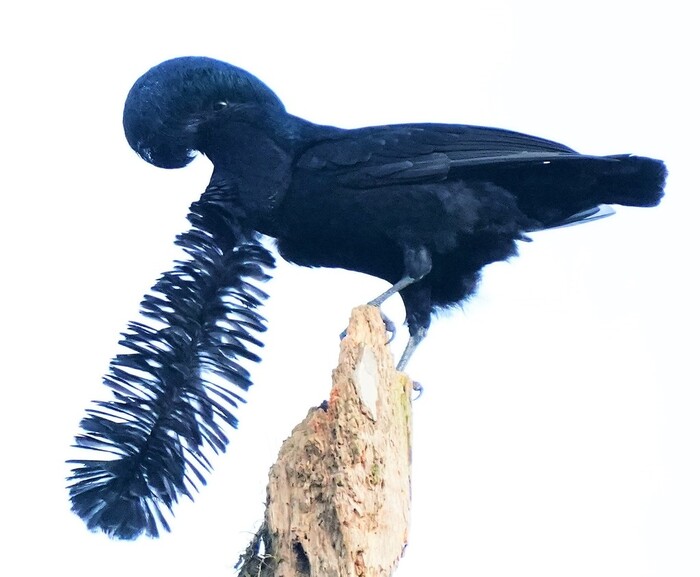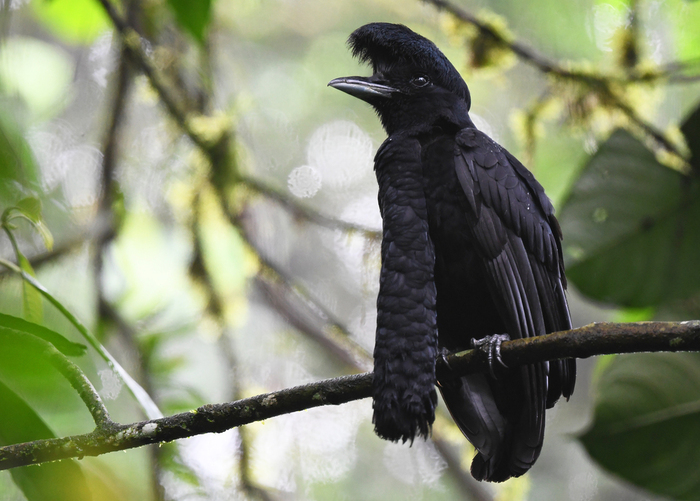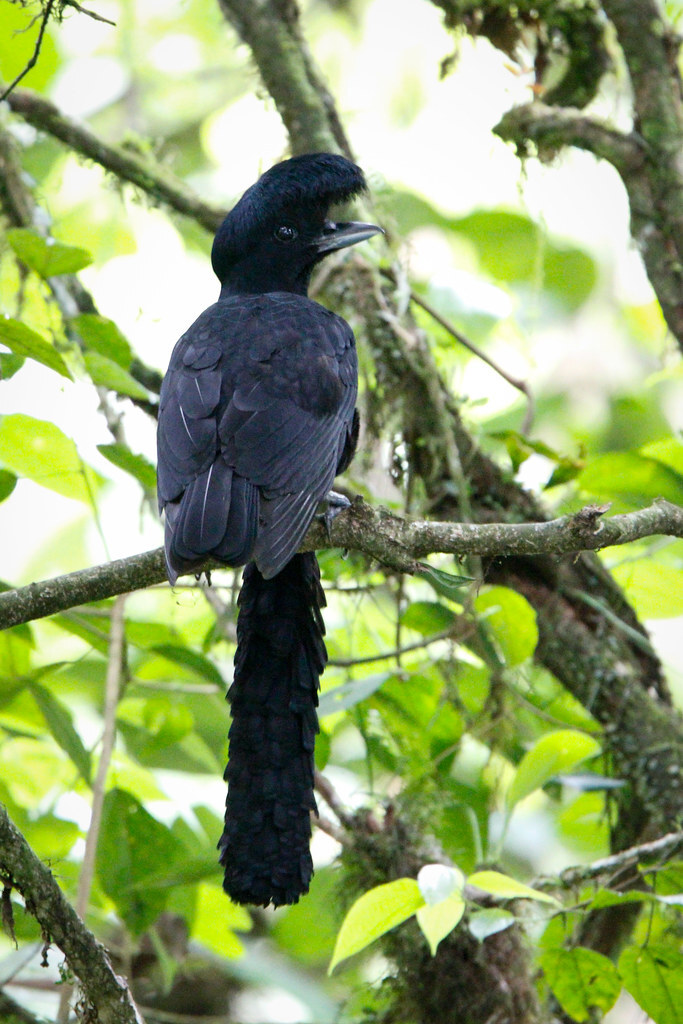The Coracine Casquée, scientifically known as Cephalopterus penduliger, is a fascinating bird native to the lush rainforests of South America. With its unique features, captivating behavior, and ecological significance, this species captures the attention of ornithologists and nature enthusiasts alike. In this comprehensive guide, we’ll dive deep into the scientific classification, morphology, behavior, and conservation status of the Coracine Casquée, and examine its ecological and cultural impact.

The Coracine Casquée belongs to the family Cotingidae, which consists of birds that are primarily found in tropical regions. Here’s a quick overview of its taxonomic classification:
Kingdom: Animalia
Phylum: Chordata
Class: Aves
Order: Passeriformes
Family: Cotingidae
Genus: Cephalopterus
Species: Cephalopterus penduliger
This classification places the Coracine Casquée alongside other stunning birds in the Cotingidae family, which includes species known for their bright colors and elaborate courtship displays.
First described by the famous ornithologist Louis Jean Pierre Vieillot in 1817, the Coracine Casquée has been a subject of fascination due to its striking physical appearance and complex behaviors. Ornithologists were initially drawn to its large casque (a helmet-like structure on the bird’s head), which serves as a key identification feature and plays a role in its mating rituals.

The Coracine Casquée stands out with its unique physical features, making it one of the most distinctive birds in the rainforests of South America.
Size: Approximately 30-35 cm in length.
Weight: Around 300 grams.
Coloration: This bird showcases a vibrant plumage, primarily dark green with tinges of blue and yellow on its wings and tail.
Distinctive Casque: The male Coracine Casquée is particularly known for its prominent casque, a large, helmet-like structure atop its head, which is more pronounced than in females.
Beak: The beak is relatively short and robust, which aids in feeding on fruits and insects.
Eyes: Bright and expressive, with dark irises.
The Coracine Casquée is native to the Amazon Basin, inhabiting the tropical rainforests of countries such as Brazil, Colombia, Peru, and Ecuador. This species prefers dense, lowland forests and is typically found at elevations of around 500 to 1,500 meters above sea level.
Rainforests: Dense tropical rainforests provide both the cover and food sources necessary for survival.
Canopy and Mid-Canopy Areas: The bird primarily resides in the upper canopy, where it can forage and perform its intricate courtship displays.
Mango, fig, and palm trees: Commonly used as perching sites and food sources.
The Coracine Casquée is not only visually captivating but also exhibits unique behaviors, especially during its mating rituals.
Display of the Casque: Male Coracine Casquée birds are known to engage in elaborate courtship displays, during which they puff out their chest, perform a series of calls, and shake their heads, highlighting the prominent casque.
Call: The call of the Coracine Casquée is a low, hoarse croak, often heard from a distance, especially during mating season.

Feeding: This bird is omnivorous, primarily feeding on fruits, berries, and insects, with a preference for figs and palm fruits. It is also known to forage in tree canopies for small vertebrates and arthropods.
Social Behavior: These birds are typically solitary or found in small groups. Males will often compete for territory and female attention.
Unlike many other birds, the Coracine Casquée does not engage in long-distance migration. However, its movements within its habitat can be influenced by seasonal changes in food availability and the climate of the Amazon rainforest. These birds may move locally to find abundant food sources, especially during dry seasons when fruiting trees are less abundant.
The Coracine Casquée is primarily frugivorous, relying on a variety of fruits and berries for nourishment. It also feeds on insects, small vertebrates, and occasional flowers. Its foraging behavior is quite strategic, as it can navigate the dense canopy with ease to reach food sources.
Breeding typically occurs during the rainy season, when food is abundant and conditions are optimal. The male Coracine Casquée performs his courtship rituals to attract a female. Once paired, the female will build a nest high in the trees, often in a secluded area of the rainforest. The female lays two or three eggs, which both parents help incubate.
Around 24-30 days.
The chicks are cared for by both parents until they are able to fend for themselves.
The Coracine Casquée is currently classified as Near Threatened (NT) on the IUCN Red List. While not immediately at risk of extinction, this bird faces several threats that could affect its long-term survival.
Population trends indicate that the Coracine Casquée is experiencing a gradual decline due to habitat loss and fragmentation, particularly in the Amazon basin, where logging, agriculture, and human encroachment are common.
The primary threats to the Coracine Casquée include:
Habitat Destruction: Deforestation, especially in the Amazon rainforest, leads to habitat loss.
Illegal Hunting: Though not a major issue, some local hunting for feathers and meat can affect populations.
Climate Change: Alterations to the habitat due to climate change may also impact their food sources and breeding success.
Efforts are underway to protect the Coracine Casquée and its habitat. These measures include:
Forest Conservation Projects: Protection of the Amazon rainforest and other key habitats.
Ecotourism: Promoting eco-friendly tourism in South America to raise awareness and generate funds for conservation.
Legal Protections: Many regions now have stricter laws in place to prevent illegal hunting and deforestation.
The Coracine Casquée plays an important ecological role in its environment. As a frugivore, it helps in seed dispersal, which is vital for the regeneration of tropical forests. Without this bird, many plant species could struggle to spread and grow, affecting the overall biodiversity of the region.
In South American cultures, the Coracine Casquée is often admired for its beauty and symbolism. While not traditionally hunted for feathers, the bird’s unique appearance makes it a subject of fascination in local folklore and art.
Economically, the Coracine Casquée is valuable for ecotourism. Bird watchers and nature enthusiasts travel to see this remarkable species, contributing to local economies.
| Species | Scientific Name | Habitat | Conservation Status |
|---|---|---|---|
| Crowned Cotingas | Cephalopterus glabricollis | Lowland rainforests | Near Threatened |
| Purple-throated Fruitcrow | Querula purpurata | Tropical forests of Amazon | Least Concern |
The Coracine Casquée (Cephalopterus penduliger) is a bird that epitomizes the beauty and complexity of tropical ecosystems. With its striking features, fascinating behavior, and ecological importance, this species is a true treasure of the Amazon rainforest. Understanding its biology, behavior, and conservation needs is essential for protecting this incredible bird and ensuring that it continues to thrive in the wild for generations to come.
animal tags: Cotingidae
We created this article in conjunction with AI technology, then made sure it was fact-checked and edited by a Animals Top editor.